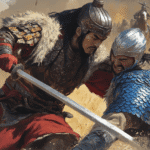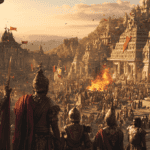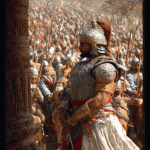
Rising from semi-nomadic Turkish military origins in the late 10th century, the Ghaznavids managed within just a few decades to transform a frontier outpost into a far-reaching empire encompassing large portions of modern Afghanistan, Iran, Pakistan, and northern India. At its peak, the Ghaznavid state was not merely a military machine: it became a crucial conduit for cultural exchange, Persianate courtly refinement, the spread of Islam, and the fusion of Central Asian, Middle Eastern, and South Asian traditions.
Origins: From Slaves to Rulers
The origins of the Ghaznavid dynasty can be traced to the Turkic slave-soldier tradition that had already been central to the politics of the Abbasid caliphate and its successor states. By the 9th and 10th centuries, rulers across the Islamic world relied heavily on skilled Turkic mamluks (military slaves), who often rose to great prominence.
One such man was Alp-Tegin, a Turkic commander in the service of the Samanids, a Persianate dynasty based in Transoxiana and Khorasan. Alp-Tegin fell out of favor at the Samanid court and in 962 marched south with his followers, eventually capturing the fortress city of Ghazna in modern Afghanistan. Though initially only a semi-autonomous warlord, Alp-Tegin laid the foundations of what his successors would elevate into a powerful dynasty. His death in 963 left his line weak, but his successors preserved control of Ghazna with intermittent struggles until his former slave-general, Sabuktigin, consolidated power.

Sabuktigin (r. 977–997): Foundation of the Dynasty
Sabuktigin is regarded as the true founder of the Ghaznavid dynasty. Originally a Turkic slave (mamluk) in Alp-Tegin’s service, he married Alp-Tegin’s daughter and eventually established himself as Ghazna’s ruler after his master’s death. His vision and leadership transformed a provincial outpost into a rising power.
Sabuktigin proved himself not only an able soldier but also a skilled administrator:
- He expanded control over Zabulistan and Kabul, regions vulnerable to raids and contested between local rulers and external forces.
- He waged consistent wars against the Hindu Shahi rulers of the Kabul Valley and eastern Afghanistan, dividing their domains and integrating them into his expanding principality.
- His loyalty to the Samanid overlords provided him with nominal legitimacy, though in practice he acted with full independence.
By the time of his death in 997, Sabuktigin had created a strong and militarized Afghan kingdom – flexible enough to profit from both the Persian bureaucratic tradition and the Turkic steppe ethos of military dominance. Crucially, he left behind two competitive heirs: Ismail and Mahmud, whose contest for succession would determine the dynasty’s future.
Mahmud of Ghazni (r. 998–1030): The Apex of Power
Perhaps no Ghaznavid is more famous than Mahmud of Ghazni, Sabuktigin’s son, who fought his way to power in 998. Mahmud transformed the Ghaznavid state into a vast empire and permanently etched his name into Islamic and South Asian history.
Mahmud secured legitimacy by proclaiming loyalty to the Abbasid caliph in Baghdad, positioning himself as a pious champion of Sunni Islam. He adopted the title Sultan, marking one of the earliest uses of this designation in Islamic political history. Through this, he distanced himself from the Samanids and presented Ghazna as the new seat of Islamic power in the eastern Islamic world.
Westward Expansion
While Ghazni’s heartland lay in Afghanistan, Mahmud embarked on campaigns across Khorasan, Rayy, and parts of Iran, defeating rival Buyid and Samanid claimants. His victories in Central Asia allowed him to dominate trade and pilgrimage routes, further enriching his imperial treasury. Ghazni, situated between the Persian plateau and the Indian subcontinent, became an ideal capital for cultural and economic dominance.

Raids into the Indian Subcontinent
Mahmud’s fame rests largely on his 17 invasions of northern India, launched over three decades. His invasions reached Mathura, Kannauj, and Somnath, deep inside India. In 1001, he defeated the Hindu Shahi at the Battle of Peshawar. In 1004–05, he invaded the Principality of Bhatiya, and in 1006 he attacked the neighbouring Emirate of Multan. In 1008–09, he again defeated the Hindu Shahis at the Battle of Chach and appointed governors in the conquered regions.
In 1018, he devastated the city of Mathura, which was ruthlessly sacked, desecrated, and destroyed. According to Muhammad Qasim Hindu Shah, who wrote a history of Hindustan in the 16th–17th century, Mathura was then the richest city in India. When Mahmud attacked it, all the idols were burnt and destroyed, the gold and silver were melted down as loot, and the city was set on fire during twenty days of pillaging. That same year, he also captured Kanauj, the capital of the Pratiharas, and confronted the Chandelas, who agreed to pay tribute.
The wealth taken from Mahmud’s Indian expeditions to Ghazni was immense. In 1026, Mahmud raided the Somnath temple and carried away a vast booty valued at 20 million dinars.
While these campaigns were partly framed in religious terms – Mahmud portrayed himself as a ghazi (holy warrior) – they were also very economically motivated. India’s temples housed immense wealth in gold, silver, and precious stones. Looting them allowed Mahmud to finance his vast empire, pay his army, and patronize scholars and artists.
Contrary to some simplistic portrayals, Mahmud did not seek to permanently govern deep into India; instead, he sought to establish strong outposts (notably at Lahore) and extract wealth through plunder and tribute.
The Ghaznavid Realm: Territory and Administration
At its zenith under Mahmud, the Ghaznavid Empire stretched across:
- Afghanistan: its birthplace and nuclear heartland.
- Khorasan and northeastern Iran: including the great cities of Nishapur and Rayy.
- Central Asia: holding sway in contested lands amid the decline of the Samanids.
- Northern India: extending power to Punjab, Sindh, and tributary relations with deeper regions of the subcontinent.
Administration
The Ghaznavids relied on a dual tradition: Turkic military leadership and Persian bureaucratic elitism.
- The army was primarily composed of Turks, Afghan highlanders, and Indian recruits, giving it flexibility and strength on multiple fronts.
- Administration, taxation, and cultural life were run through the expertise of Persian viziers and officials, ensuring continuity with Samanid and earlier traditions.
- Ghazni itself was developed into a sumptuous capital: elaborately adorned with mosques, palaces, libraries, and gardens, serving as a showcase of their wealth and patronage.
Mahmud’s court in Ghazni was not merely militaristic; it was a center of Persianate culture. He promoted Persian as the language of administration and high culture, while patronizing poets, scholars, and theologians. The most famous of these was Ferdowsi, author of the Persian epic Shahnameh, though Mahmud’s strained relationship with the poet is legendary.
Ghazni’s transformation into a bustling cultural capital marked the shift of Persianate civilization eastward, blending Turkish military leadership with Persian bureaucratic and artistic traditions.
Mahmud’s death in 1030 left his heirs with an empire that was outwardly resplendent but internally fragile. The sheer size of the realm and its dependence on constant military campaigns, combined with the rise of new rivals, destabilized Ghaznavid control.
Mas‘ud I and the Seljuk Challenge
Mahmud’s son, Mas’ud I (1030–1040), inherited the throne amidst factional disputes. He faced a new and formidable rival: the Seljuks, another Turkic power rising from the steppes. Mahmud’s brother Mas’ud requested three provinces which he claimed through conquest, but Mohammed refused. This led to conflict, and Mas’ud fought against his brother, ultimately defeating him. He became king, while Mohammed was blinded and imprisoned as punishment.
Mas’ud, however, failed to preserve the empire. After a devastating defeat at the Battle of Dandanaqan in 1040, he lost all the Ghaznavid territories in Persia and Central Asia to the Seljuks, plunging the realm into a period of turmoil. His final attempt at regaining power was to collect treasures from his forts in hopes of raising an army and ruling from India. Instead, his own troops plundered the wealth, and he was compelled to reinstall his blind brother Mohammed on the throne. The brothers traded places: Mohammed was taken from prison and crowned king, while Mas’ud was sent to a dungeon. After ten years of rule, Mas’ud was assassinated in 1040.
Mas’ud’s son, Madood, then governor of Balkh, rushed to Ghazni to claim kingship upon hearing of his father’s death. He fought Mohammed’s sons and emerged victorious, seizing the throne. Yet the empire rapidly unraveled, as many rulers refused to acknowledge his authority. Within just nine years, four more kings rose to claim the throne of Ghazni.
The Shift to India
After their losses in Central Asia and Iran, the Ghaznavids increasingly turned toward Punjab and northern India as their stable base of power. Cities like Lahore became alternate capitals, while Ghazni itself remained symbolic but overshadowed. This geographical shift signaled their transformation from a trans-regional empire into a more localized Indo-Afghan kingdom.

Later Struggles and Decline
Over the next century, the Ghaznavids fought a losing battle to maintain relevance:
- They came under increasing vassalage to the Seljuks in the west.
- Indian territories were gradually eroded by local Rajput resistance and later by the up-and-coming Ghurids of central Afghanistan.
- By the mid-12th century, the Ghaznavid state was a shadow of its former self. In 1186, the last Ghaznavid ruler, Khusrav Malik, was defeated by the Ghurids, formally ending the dynasty.
Legacy of the Ghaznavid Dynasty
Despite its decline, the Ghaznavid dynasty left a durable imprint on history, particularly in Afghanistan and South Asia.
While Islam already existed in Sindh since the Umayyad conquest of the 8th century, the Ghaznavids deepened its penetration into northern India. Their permanent bases in Punjab facilitated cultural and religious exchange, laying groundwork for the later prominence of Islamic rule under the Delhi Sultanate.
The Ghaznavids were pivotal in transferring Persianate court culture into South Asia. Persian became the language of administration, high culture, and literary expression, enduring well into the Mughal era. The dynasty is crucial to understanding why Persian remained influential across northern India for centuries.
Mahmud of Ghazni’s use of the title Sultan became highly influential. His model of strong military leadership combined with Islamic legitimacy and Persian bureaucracy foreshadowed the Delhi Sultanate and other Muslim dynasties in India.
Though less well-preserved than later dynasties, Ghaznavid-era monuments in Ghazni, such as towers, mosques, and palaces, reflect a blending of Persian-Islamic and Central Asian styles. Many of these later influenced Afghan and Indian architecture.
Conclusion
The story of the Ghaznavid dynasty – rising from a Turkish slave background in Afghanistan, expanding across Iran and India under Mahmud’s thunderous campaigns, and declining under Seljuk and Ghurid pressure – epitomizes the dynamism of medieval Islamic history.
From a fortress in Ghazna, they projected power across half a continent, making theirs one of the most remarkable stories of medieval state-building in Asia.




